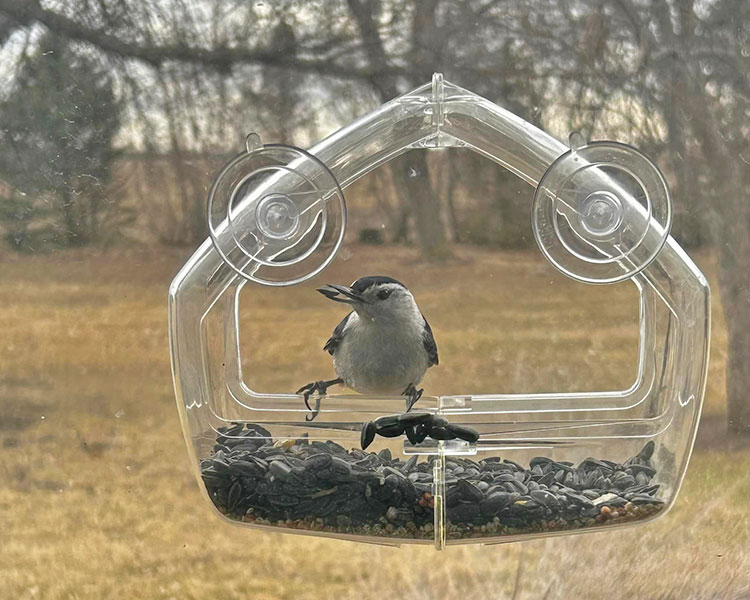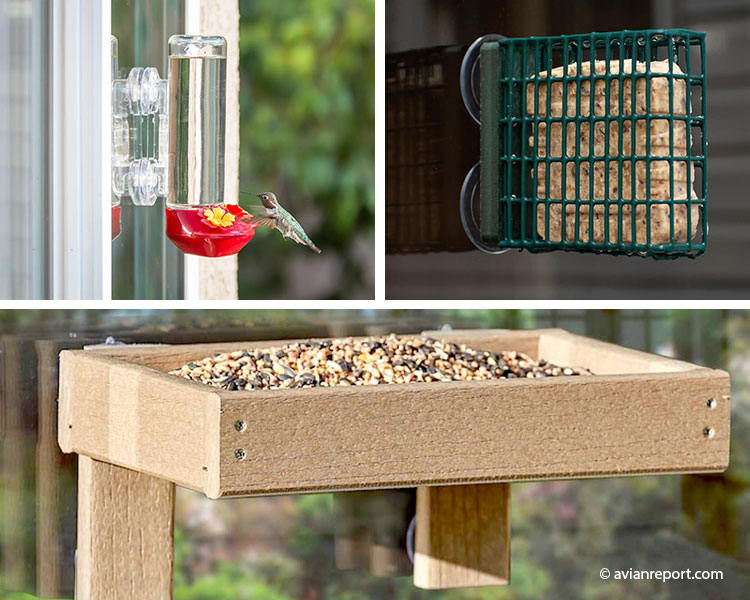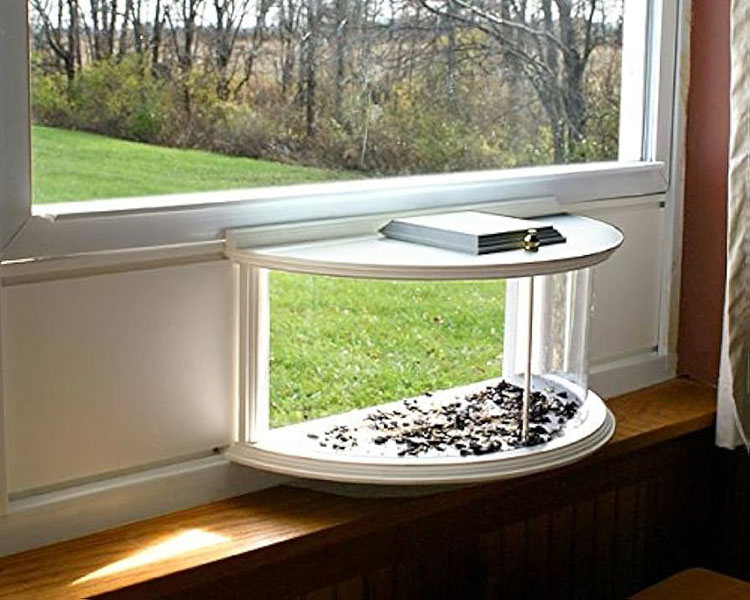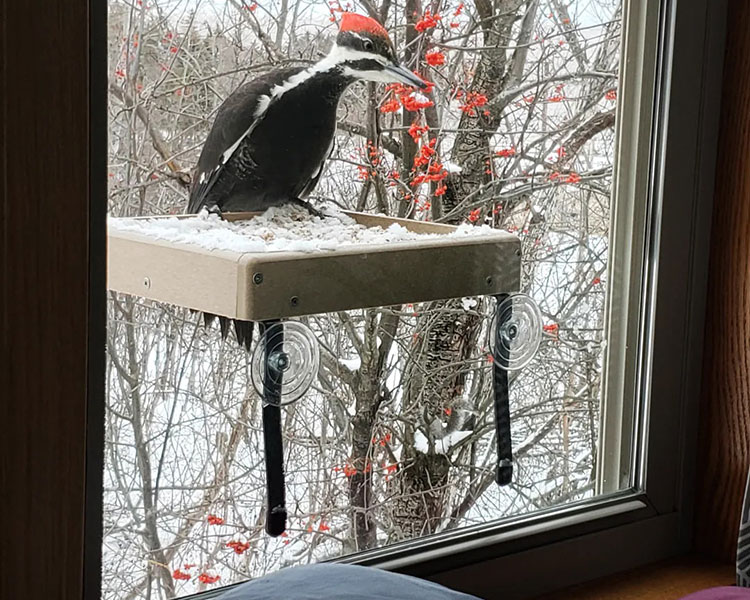Window bird feeders are for bird enthusiasts who want to enjoy close-up birds from inside their home. Also ideal for apartment dwellers and others who have no actual yard and enjoy feeding birds. They are easy to maintain. However, shy and ground feeding birds appear to avoid approaching windows. Potential for messiness is an important consideration.

What is a window bird feeder?
A window bird feeder is a small feeder specifically designed to attach directly to a window, allowing you to observe birds feeding from inside your home. The majority attach to a window pane, but there are semicircular designs that can actually extend into your house below double-hung windows (windows that open vertically).
How does a window bird feeder work?
- Attachment: Window feeders typically use strong suction cups to adhere directly to the glass of your window.
- Seed Tray and Perches: The feeder has a small tray to hold birdseed and one or more perches for birds to land on comfortably while they feed. Some designs have no perches.
- Clear Design: The feeder is often made of clear plastic to provide an unobstructed view of the birds from inside.
Different Window Settings:
Window feeders can work with various window types as long as they have a clean, smooth surface for the suction cups to grip. Here are some things to consider:
- Double-Hung Windows: These windows open vertically and can accommodate feeders placed on the lower or upper pane.
- Sliding Windows: Attach the feeder to a clean section of the stationary pane.
- Casement Windows: Similar to sliding windows, feeders can be placed on the fixed pane. Just ensure they don’t obstruct opening the window.
Related:
Fruit & Jelly Bird Feeders
Hummingbird Nectar Feeders
Suet Bird Feeders

Attract More Birds to Your Window Feeder
Window bird feeders can attract a wide variety of birds, including chickadees, finches, nuthatches, and woodpeckers. But where you place the feeder matters! To attract the most birds, position it on windows near trees and bushes. Birds that live in trees and bushes prefer to feed close by so they can dart for cover if a predator appears. This is why feeders on windows in the first floor tend to be more popular than those on higher floors.
Ground-feeding birds like sparrows typically won’t visit window feeders. If you want to attract these birds, consider placing platform feeders on the ground instead.
I have experimented with feeders on windows facing the front yard, which has short-trimmed bushes and a mowed lawn. Only a pair of cardinals were regular visitors. Conversely, tube and platform feeders in my backyard where bushes and trees are plentiful were visited by multiple species of birds and individuals per species.
Description of the Feeder:
- Material: Window feeders are typically made of clear plastic or shatter-resistant polycarbonate for durability and clear bird viewing.
- Design: Clear plastic feeders with suction cups for attaching to window panes or small covered trays for window sills. These feeders allow a close-up viewing experience. They come in various shapes, including rectangles, squares, and half-circles.
- Features: They have one or more feeding ports with perches for birds to land on while feeding. Some feeders have drainage holes and removable trays for easy cleaning. A few models may incorporate a one-way mirror design, allowing you to see the birds clearly while they can’t see you inside.
- Size and Variety: Window feeders come in a variety of sizes, accommodating different window spaces. They typically hold less seed than other feeder types due to their space limitations.

Seed and food Types:
- Window feeders are suitable for offering a variety of seed mixes including black-oil sunflower seeds, millet, shelled peanuts, and mixed bird seed.
- Some window feeders offer nectar for hummingbirds and suet for woodpeckers and wrens.
Seed Capacity:
- Seed capacity is typically on the smaller side due to size constraints, ranging from a few ounces to one cup of seed.
Refilling Recommendation:
Because of the smaller seed capacity, window feeders may require more frequent refilling.
Related:
Globe Bird Feeders
Thistle Bird Feeders
Hopper or House Bird Feeders
Birds Attracted:
As mentioned above, the success of window feeders in attracting birds has to do with the location of the window/feeder. Some can be visited by a wide variety of birds while others go largely unvisited. Some common visitors more likely to visit window feeders include:
- Finches (house finch, purple finch)
- House sparrows
- Cardinals
Other less likely visitors that have been recorded visiting window feeders include:
- Nuthatches
- Chickadees
- Woodpecker
- Grosbeaks
- Titmice
Advantages:
- Offers close-up bird watching from the comfort of your home.
- Easy to refill and clean due to the accessible design.
- Space-saving option for smaller areas.
- Clear material allows for unobstructed viewing of birds and monitoring of the birdseed level in the feeder.
Disadvantages:
- Limited seed capacity requires frequent refilling.
- May not attract as wide a variety of birds compared to other feeder types. Shy and ground feeding birds appear to avoid feeding near windows.
- Can be messy if seed spills from the feeder onto the windowsill below.
- Window placement is crucial – needs to be positioned where birds feel safe to land and feed.
- May attract larger birds like doves and jays that suction cups cannot support.

Related:
Tube Bird Feeders
Tray (Platform) Bird Feeder
Key Takeaways about Window Bird Feeders:
Window feeders are for bird enthusiasts who want to enjoy close-up birds from inside their home.
- Close-Up Birding: Window feeders offer a unique opportunity to observe birds feeding from the comfort of your home.
- Easy Installation: Suction cups allow for quick attachment to clean window surfaces.
- Clear View: Transparent materials provide an unobstructed view of the birds.
- Window Compatibility: They work with various window types (double-hung, sliding, casement) as long as there’s a smooth surface for suction.
- Attracts Specific Birds: Smaller birds comfortable near windows are frequent visitors (Finches, Jays, cardinals). Other birds may avoid window feeders.
- Limitations: Hold less seed and may frequent refilling.
- Not a Universal Solution: Consider using traditional feeders alongside window feeders to attract a wider variety of birds.
Author: